Four Distinctive Artists
By Emilia Dubicki, WTP Art Correspondent
This season, I found myself drawn especially to exhibitions that dealt with place and space. Nature and man-made structures, along with the moods, light, and colors they evoke, are approached distinctively by artists Matthias Meyer, Andro Wekua, Jennifer Bartlett, and Richard Anuszkiewicz, while all of these artists clearly dwell deeply within their work and its inspirations.
In the exhibit Silent Water, Meyer’s paintings filled the spacious Danese Corey Gallery in Chelsea with dream-like depictions of the natural world, like windows onto blurred wetlands, pools, and marine vegetation, where the real meets abstraction. The repetition of watery blue, purple, and green oils on linen bleeding and spilling like watercolors and creating vertical ribbons of color gave this viewer a feeling of being just under the water’s surface; at other times of hovering over the water or standing before curtains of water and sea grasses.
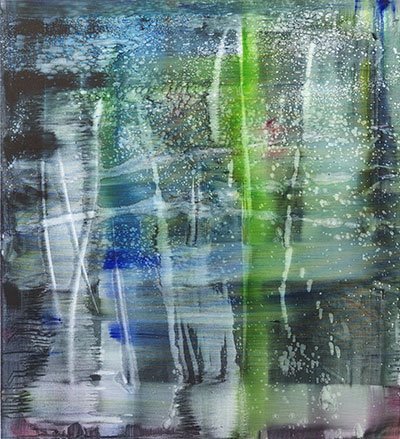
Photographed by Giorgio Morra, Courtesy Danese/Corey
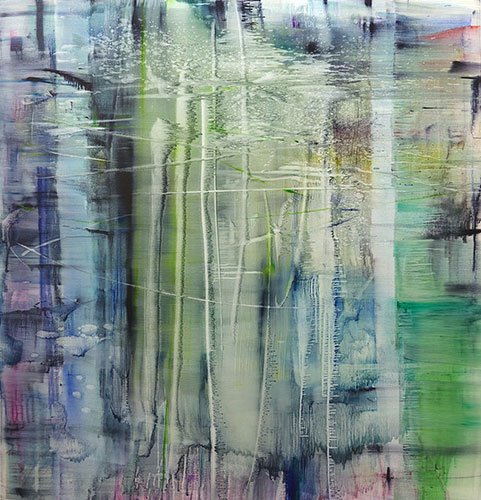
Photographed by Giorgio Morra, Courtesy Danese/Corey
Meyer, who was born and lives in Germany, studied with Gerhard Richter, and I could see a Richter influence in how Meyer integrates and spreads his colors across the canvas. Richter used a squeegee to blend bands of color and Meyer achieves a similar visual effect by allowing paint to run and bleed, to shimmer with light and illusions of reflections in his translucent layers where the physical world meets states of mind and being.
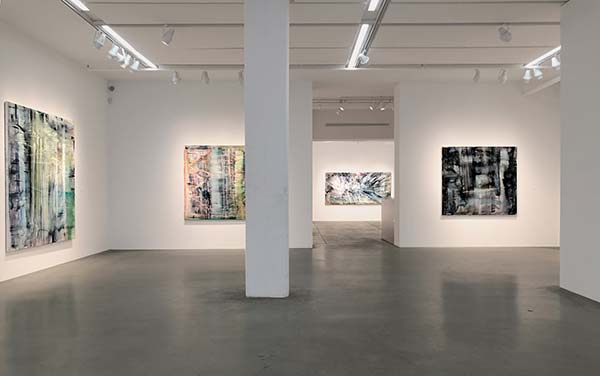
Courtesy Danese/Corey
The painting “Insomnia,” with its horizontal landscape format, is a moody representation of what could be an icy blue-green pond beneath watery drops and slashes of inky black-and-white scratches on ice. Does the title reference the artist working sleeplessly through the night or is it a visualization of what insomnia might look like if it had a physical form? Whatever Meyer’s reason for his title, the mystery is for the viewer to contemplate.
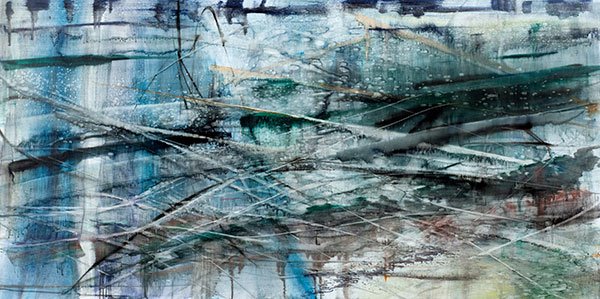
Photographed by Giorgio Morra, Courtesy Danese/Corey
Gladstone Gallery is featuring new paintings and sculptures by multidisciplinary artist Andro Wekua. It is difficult to describe what is happening In Wekua’s work, but the brooding moodiness and openings of light culminate into a kind of obscured narrative—we see faces, seascapes, dolphins, and plant life reappear in the works, but it’s never quite clear who or where we are.
Wekua works oil paint, silkscreen ink, silver leaf and varnish onto aluminum panels to collage-like effects. In the large work “What You Gonna Do,” two darkened figures—seemingly of a young girl with the arms of the second figure wrapped around her—dominate the left side of the painting while the work’s center, flanked in flames, is a layered portal into a bright distance. Or is it a void?
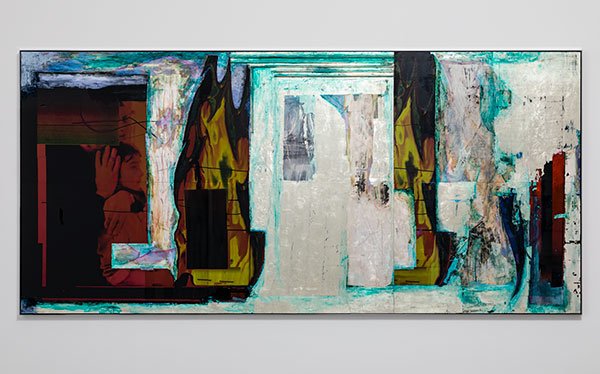
Copyright Andro Wekua, Courtesy the artist and Gladstone Gallery, New York and Brussels
photography by David Regen
The bronze sculpture “Slow Singing, Flower Bringing” of Eros encircled by a dolphin was inspired by a second-century sculpture from the Farnese Collection in Naples. Wekua has given his own Eros and dolphin realistic glass eyes that animate the piece, as they appear to stare back at the viewer. A quirky artificial magnolia stem dangles from Eros’ toe as if a gift left by an admirer. In his painting “A Portrait,” a face is rendered in blue washes, with one eye looking out from behind a white flower stem. In the upper right, a warm purple mixes with the blues, diffusing into a kind of twilight, to conjure the flower’s fragrance.
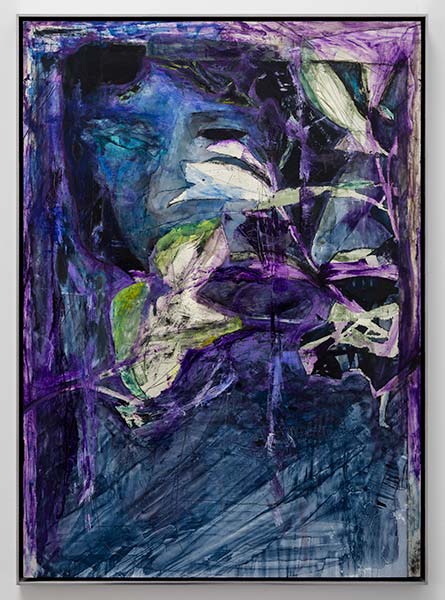
Copyright Andro Wekua Courtesy the artist and Gladstone Gallery, New York and Brussels
Photography by David Regen
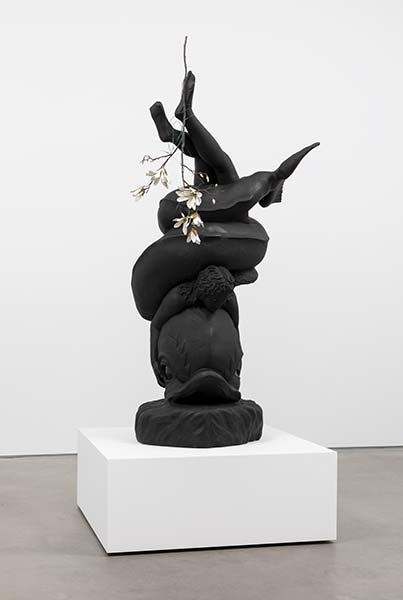
Copyright Andro Wekua Courtesy the artist and Gladstone Gallery, New York and Brussels
Photography by David Regen
On a wall by itself is the large “Braiding Rain,” a seascape also with washes of blue. Approaching the work from the far end of the gallery, I gradually began to make out what the dark head in the bottom foreground is looking at—an equally darkening sky above the horizon. It is this painting that sums up for me the spirit of this exhibit: are we leaving the known behind or are we approaching the unknown?
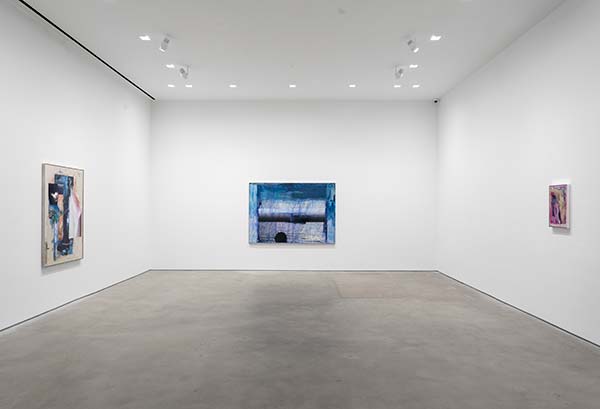
Courtesy the artist and Gladstone Gallery, New York and Brussels
photography by David Regen
Jennifer Bartlett’s current exhibit The House was Quiet and the World was Calm: Jennifer Bartlett, 1970–2014 at the Marianne Boesky Gallery reflects the artist’s ongoing interest in house as subject, whether it’s her own or the idea of house as a geometric square topped with a triangle roof. Bartlett’s exploration of the theme is through grids she employs regularly, combined with the geometric and an expressive painting style.
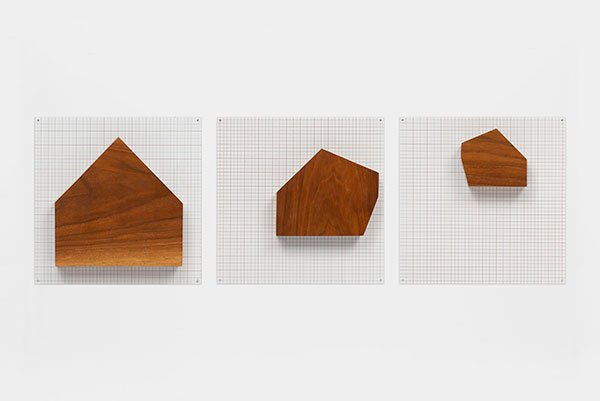
© Jennifer Bartlett. Courtesy Marianne Boesky Gallery, New York and Aspen, Paula Cooper Gallery, New York, and The Jennifer Bartlett 2013 Trust
Photo credit: Peter Kaiser
The grids serve as a kind of structure for the loose paint-laden dots. In “Glass House on Plate” a blue paint-splattered house evokes an energy that cannot be contained by its boundaries. Often Bartlett paints on square steel plates installed in grid format to create much larger works. Each plate with its lines, dots, colors, and textures is an autonomous work, but within the greater abstract composition, images and patterns emerge as in “Large House: Dots.” Viewed from a distance, the outline of a house emerges in this quilt-like painting of squares within a square.
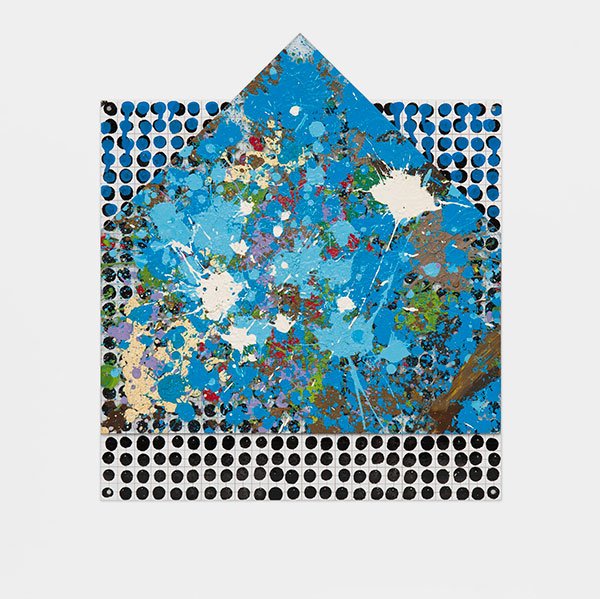
© Jennifer Bartlett. Courtesy Marianne Boesky Gallery, New York and Aspen, Paula Cooper Gallery, New York, and The Jennifer Bartlett 2013 Trust
Photo credit: Peter Kaiser
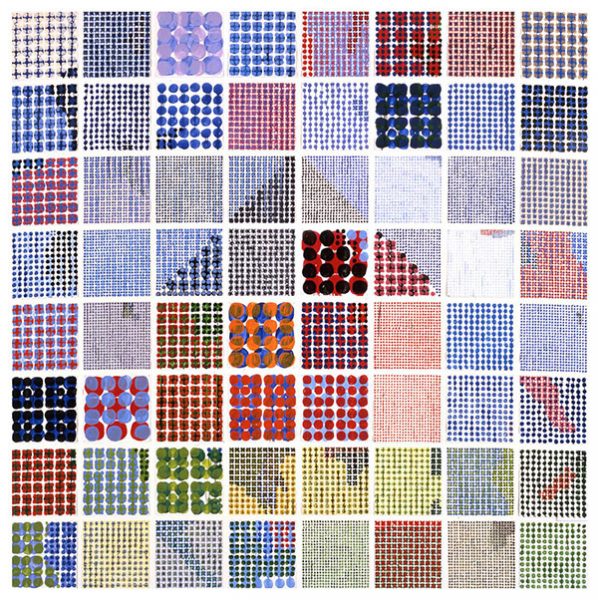
The multimedia work “Double House” is oil on canvas combined with a wooden construction. The painting is of two askew sections of a gray clapboard house against a background of grass, trees, and sky. The roof shingles themselves are a grid, each shingle painted with lines and dabs of faint color. A replica of the house, constructed of wood and painted white, partially obstructs the painting like a 3-D extension. One has to stand at an angle to see the painting in its entirety, and along with the white ghost house, all is slightly off kilter.
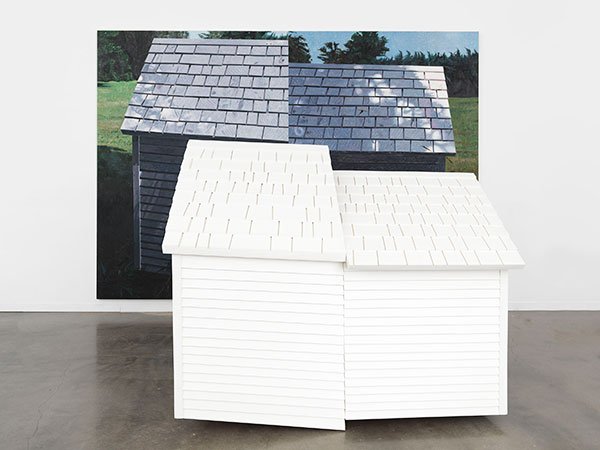
© Jennifer Bartlett. Courtesy Marianne Boesky Gallery, New York and Aspen, Paula Cooper Gallery, New York, and The Jennifer Bartlett 2013 Trust
Photo credit: Object Studies
This thought-provoking survey of the artist’s continuing exploration and recreation of the house reveals Bartlett’s broad, layered creative range. With the many exteriors, facades, and settings that she breaks down and builds back up, Bartlett conveys the inner complexity of home without our even having to glimpse their interiors. As I was leaving the gallery, on the front desk I found a copy of a personal essay written by Bartlett’s daughter Alice Carriere. Titled “The House was Quiet and the World Was Calm: My mother’s houses – in her paintings, her paintings inside,” Carriere wonderfully describes growing up in various houses with all of their peculiarities and her mother’s ideas of what made a home. Carriere tells us, “These houses were also a fortress that housed an inner core of stillness, a calm that could only be found in work: the work that created them and the works that were created between and upon their walls. A world, made of floors and ceilings or dots and grids – that had its own rules.”
At the Loretta Howard Gallery in Chelsea, the walls radiated with the vibrant lines and bands of color in Richard Anuszkiewcz’s Temple Series paintings, inspired in part by the architecture of Egyptian and Greek temples, specifically the space in between the repetitious vertical columns. In his Op Art style, the artist has juxtaposed complimentary colors to create sensory realities and illusions. Cadmium red reverberates against teal; purple, blue, and orange recede and re-emerge, challenging the viewer to discern what is optically happening in each work.
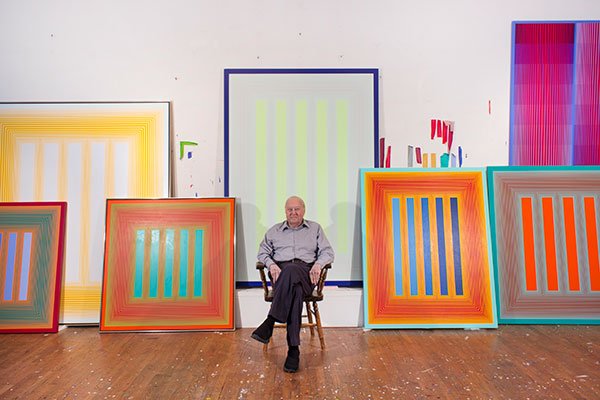
Courtesy of Loretta Howard Gallery
Anuszkiewicz’s paintings prove that, as his mentor Joseph Albers theorized, color is relative to its surroundings—the same blue against green can look very different beside yellow-orange. There are no unnecessary details in these paintings. The uniformity of spacing and lines has a collective stimulating effect, transporting one in and out of these Temples.
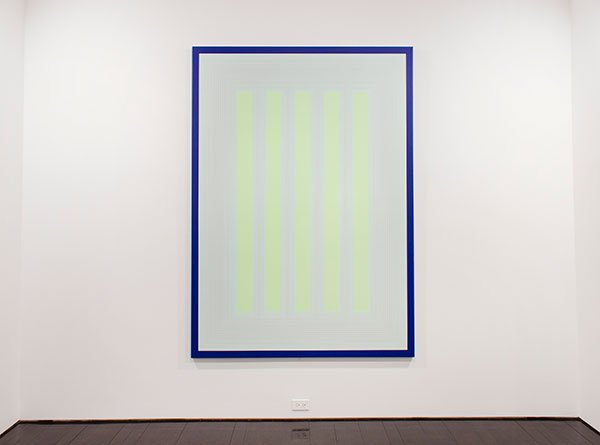
Courtesy of Loretta Howard Gallery
“Temple of Green Mist,” a large vertical painting on the gallery’s back wall, lured me into its central pale green planes on a field of thin white lines. There is indeed a sense of mist, as a crisp border of royal blue paint seemingly rises up around this temple. As I stepped back, the brighter colors of the surrounding paintings competed for attention. It was a heady mix of what I felt was sound for the eyes not ears, as if the painting emitted a pulsating electronic instrumental track with passages of chill beats—at once very classic and contemporary.
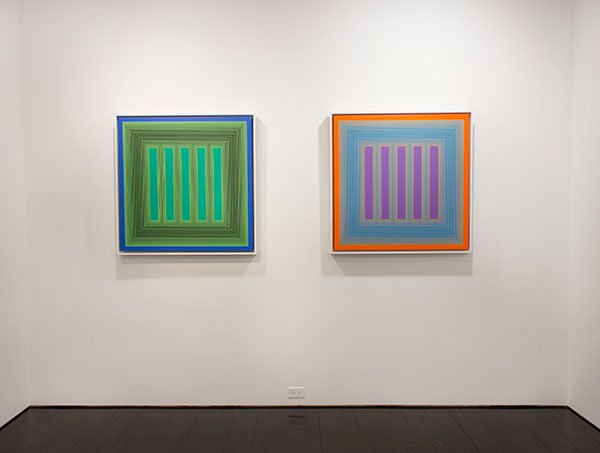
Courtesy of Loretta Howard Gallery
Enjoy more of our WTP exhibition reviews here.
If you are interested in becoming an art correspondent for WTP, please inquire at wtp@thewoventalepress.net
Copyright 2019 Woven Tale Press LLC. All Rights Reserved.
